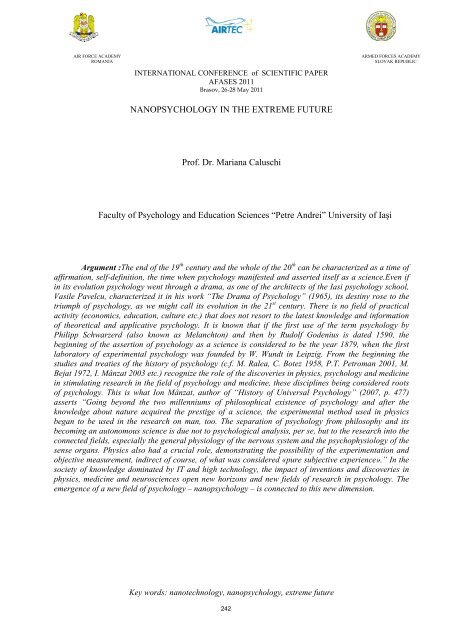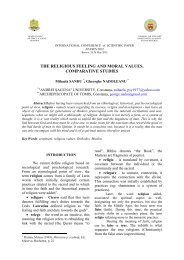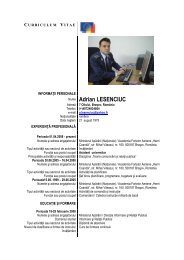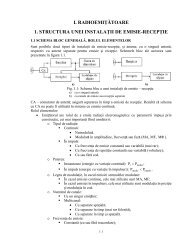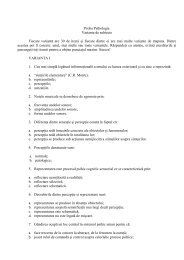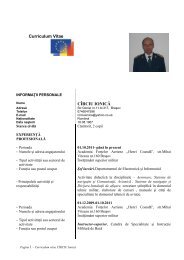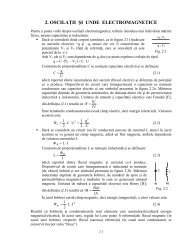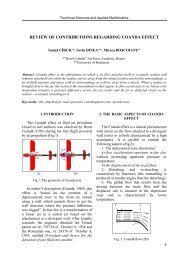Nanopsychology in the Extreme Future
Nanopsychology in the Extreme Future
Nanopsychology in the Extreme Future
Create successful ePaper yourself
Turn your PDF publications into a flip-book with our unique Google optimized e-Paper software.
“HENRI COANDA” GERMANY “GENERAL M.R. STEFANIK”<br />
AIR FORCE ACADEMY ARMED FORCES ACADEMY<br />
ROMANIA SLOVAK REPUBLIC<br />
INTERNATIONAL CONFERENCE of SCIENTIFIC PAPER<br />
AFASES 2011<br />
Brasov, 26-28 May 2011<br />
NANOPSYCHOLOGY IN THE EXTREME FUTURE<br />
Prof. Dr. Mariana Caluschi<br />
Faculty of Psychology and Education Sciences “Petre Andrei” University of Iaşi<br />
Argument :The end of <strong>the</strong> 19 th century and <strong>the</strong> whole of <strong>the</strong> 20 th can be characterized as a time of<br />
affirmation, self-def<strong>in</strong>ition, <strong>the</strong> time when psychology manifested and asserted itself as a science.Even if<br />
<strong>in</strong> its evolution psychology went through a drama, as one of <strong>the</strong> architects of <strong>the</strong> Iasi psychology school,<br />
Vasile Pavelcu, characterized it <strong>in</strong> his work “The Drama of Psychology” (1965), its dest<strong>in</strong>y rose to <strong>the</strong><br />
triumph of psychology, as we might call its evolution <strong>in</strong> <strong>the</strong> 21 st century. There is no field of practical<br />
activity (economics, education, culture etc.) that does not resort to <strong>the</strong> latest knowledge and <strong>in</strong>formation<br />
of <strong>the</strong>oretical and applicative psychology. It is known that if <strong>the</strong> first use of <strong>the</strong> term psychology by<br />
Philipp Schwarzerd (also known as Melanchton) and <strong>the</strong>n by Rudolf Godenius is dated 1590, <strong>the</strong><br />
beg<strong>in</strong>n<strong>in</strong>g of <strong>the</strong> assertion of psychology as a science is considered to be <strong>the</strong> year 1879, when <strong>the</strong> first<br />
laboratory of experimental psychology was founded by W. Wundt <strong>in</strong> Leipzig. From <strong>the</strong> beg<strong>in</strong>n<strong>in</strong>g <strong>the</strong><br />
studies and treaties of <strong>the</strong> history of psychology (c.f. M. Ralea, C. Botez 1958, P.T. Petroman 2001, M.<br />
Bejat 1972, I. Mânzat 2003 etc.) recognize <strong>the</strong> role of <strong>the</strong> discoveries <strong>in</strong> physics, psychology and medic<strong>in</strong>e<br />
<strong>in</strong> stimulat<strong>in</strong>g research <strong>in</strong> <strong>the</strong> field of psychology and medic<strong>in</strong>e, <strong>the</strong>se discipl<strong>in</strong>es be<strong>in</strong>g considered roots<br />
of psychology. This is what Ion Mânzat, author of “History of Universal Psychology” (2007, p. 477)<br />
asserts “Go<strong>in</strong>g beyond <strong>the</strong> two millenniums of philosophical existence of psychology and after <strong>the</strong><br />
knowledge about nature acquired <strong>the</strong> prestige of a science, <strong>the</strong> experimental method used <strong>in</strong> physics<br />
began to be used <strong>in</strong> <strong>the</strong> research on man, too. The separation of psychology from philosophy and its<br />
becom<strong>in</strong>g an autonomous science is due not to psychological analysis, per se, but to <strong>the</strong> research <strong>in</strong>to <strong>the</strong><br />
connected fields, especially <strong>the</strong> general physiology of <strong>the</strong> nervous system and <strong>the</strong> psychophysiology of <strong>the</strong><br />
sense organs. Physics also had a crucial role, demonstrat<strong>in</strong>g <strong>the</strong> possibility of <strong>the</strong> experimentation and<br />
objective measurement, <strong>in</strong>direct of course, of what was considered «pure subjective experience».” In <strong>the</strong><br />
society of knowledge dom<strong>in</strong>ated by IT and high technology, <strong>the</strong> impact of <strong>in</strong>ventions and discoveries <strong>in</strong><br />
physics, medic<strong>in</strong>e and neurosciences open new horizons and new fields of research <strong>in</strong> psychology. The<br />
emergence of a new field of psychology – nanopsychology – is connected to this new dimension.<br />
Key words: nanotechnology, nanopsychology, extreme future<br />
242
1. NANOPSYCHOLOGY – FORCE OF THE<br />
EXTREME FUTURE<br />
WHAT IS THE EXTREME FUTURE<br />
In <strong>the</strong> 1970s, Alv<strong>in</strong> Toffler, famous<br />
futurologist, drew <strong>the</strong> scientific world’s<br />
attention by announc<strong>in</strong>g <strong>the</strong> impact that <strong>the</strong><br />
development of technologies was go<strong>in</strong>g to<br />
have upon mank<strong>in</strong>d, us<strong>in</strong>g <strong>the</strong> term <strong>the</strong> shock<br />
of <strong>the</strong> future, while J. Naisbitt marked <strong>the</strong><br />
ma<strong>in</strong> megatendencies that would determ<strong>in</strong>e<br />
<strong>the</strong> evolution of mank<strong>in</strong>d <strong>in</strong> <strong>the</strong> future.<br />
The mapp<strong>in</strong>g of <strong>the</strong> future became a<br />
preoccupation of futurologists, but also of<br />
economists, bus<strong>in</strong>essmen and politicians more<br />
and more frequently conv<strong>in</strong>ced by <strong>the</strong><br />
syntagm “The future of <strong>the</strong> past is <strong>in</strong> <strong>the</strong><br />
future, <strong>the</strong> future of <strong>the</strong> present is <strong>in</strong> <strong>the</strong> past,<br />
<strong>the</strong> future of <strong>the</strong> future is <strong>in</strong> <strong>the</strong> present” (J.<br />
Naisbitt, 1989, p.2).<br />
To fill <strong>in</strong> <strong>the</strong> puzzle of <strong>the</strong> future, <strong>in</strong><br />
2006 James Canton, Alv<strong>in</strong> Toffler’s disciple<br />
and collaborator, launches and def<strong>in</strong>es <strong>the</strong><br />
term “extreme future”, dedicat<strong>in</strong>g it <strong>the</strong> work<br />
“Challenges of <strong>the</strong> future. Ma<strong>in</strong> trends that<br />
will reshape <strong>the</strong> world <strong>in</strong> <strong>the</strong> next 5, 10, 20<br />
years.”<br />
“Welcome to <strong>the</strong> extreme future”,<br />
James Canton said. “Everybody must change<br />
<strong>the</strong>ir attitude to <strong>the</strong> future, a future marked by<br />
changes, challenges and risks. It is a new type<br />
of future, different from mov<strong>in</strong>g from one<br />
stage to ano<strong>the</strong>r on an evolution marked by <strong>the</strong><br />
brief flashes of <strong>the</strong> <strong>in</strong>novations characteriz<strong>in</strong>g<br />
<strong>the</strong> greatest part of history. The future we live<br />
<strong>in</strong> depends on <strong>the</strong> way we understand <strong>the</strong><br />
stunn<strong>in</strong>g changes <strong>in</strong> store for us.” Major<br />
changes are <strong>in</strong> store for us, changes <strong>the</strong> quoted<br />
author calls <strong>the</strong> extreme future, describ<strong>in</strong>g it as<br />
extremely dynamic, turbulent and<br />
pluridimensional. In J. Cauton’s op<strong>in</strong>ion<br />
(2010, p. 18) <strong>the</strong> extreme future will be<br />
def<strong>in</strong>ed by five factors: speed, complexity,<br />
risk, change and <strong>the</strong> unpredictable and by ten<br />
ma<strong>in</strong> tendencies (2010, p. 15), of which<br />
mention should be made of <strong>the</strong> follow<strong>in</strong>g:<br />
One tendency refers to <strong>the</strong> energy of <strong>the</strong> future<br />
– <strong>the</strong> energy crisis, <strong>the</strong> post petrol future and<br />
<strong>the</strong> future of alternative energy, like hydrogen<br />
and nanoenergy (2010, p. 49)<br />
The second dimension is <strong>the</strong> <strong>in</strong>novation-based<br />
economy – transform<strong>in</strong>g global economy<br />
rely<strong>in</strong>g on <strong>the</strong> convergence of free trade,<br />
technology and democracy, thus lead<strong>in</strong>g to <strong>the</strong><br />
appearance of new jobs, new markets,<br />
globalization, competition, peace and security.<br />
The four <strong>in</strong>struments of force of <strong>the</strong><br />
<strong>in</strong>novation-based economy are<br />
nanotechnology, biotechnology, IT and<br />
neurotechnology.<br />
A third dimension shows <strong>the</strong> reasons why <strong>the</strong><br />
future work force must embrace <strong>in</strong>novations <strong>in</strong><br />
order to become competitive at a global level.<br />
The medic<strong>in</strong>e ensur<strong>in</strong>g longevity is considered<br />
among <strong>the</strong> key-forces that will radically<br />
change medic<strong>in</strong>e, like nanotechnology,<br />
neurotechnology and genomics, so that people<br />
will enjoy a longer, healthier life.<br />
Ano<strong>the</strong>r tendency characteriz<strong>in</strong>g <strong>the</strong> future is<br />
<strong>the</strong> way <strong>in</strong> which <strong>the</strong> science of <strong>the</strong> future will<br />
change every aspect of our existence, culture<br />
and economy from nanobiology to multiple<br />
universes.<br />
A tendency that is already manifest <strong>in</strong> <strong>the</strong><br />
future present is ensur<strong>in</strong>g security – <strong>the</strong> major<br />
threats at people’s freedom and def<strong>in</strong><strong>in</strong>g <strong>the</strong><br />
risks specific to <strong>the</strong> 21 st century.<br />
The future of globalization: <strong>the</strong> clash of<br />
cultures – <strong>the</strong> new realities of global<br />
commerce and competition; <strong>the</strong> rise of Ch<strong>in</strong>a<br />
and India; <strong>the</strong> confrontation between cultures<br />
and values; <strong>the</strong> ideological fight for<br />
dom<strong>in</strong>at<strong>in</strong>g <strong>the</strong> future - a challenge and a<br />
direction <strong>in</strong> <strong>the</strong> map of <strong>the</strong> future.<br />
To <strong>the</strong> tendencies presented here, that are a<br />
reason for concern, to <strong>the</strong> changes of <strong>the</strong> clime<br />
and to what <strong>the</strong> future may br<strong>in</strong>g <strong>in</strong> <strong>the</strong><br />
context of <strong>the</strong>ir manifestation at <strong>the</strong> level of<br />
<strong>the</strong> <strong>in</strong>dividual are added questions regard<strong>in</strong>g<br />
<strong>the</strong> necessary changes and <strong>the</strong> way people<br />
must act so that <strong>the</strong>y can sail among <strong>the</strong><br />
threats com<strong>in</strong>g from technology, governments<br />
and ideologies <strong>in</strong> <strong>the</strong>ir fight for human rights,<br />
freedom and <strong>in</strong>dividual <strong>in</strong>dependence. These<br />
are <strong>the</strong> questions that <strong>the</strong>oriticians and<br />
practitioners are try<strong>in</strong>g to f<strong>in</strong>d solutions to and<br />
all eyes are directed to <strong>the</strong> power of education<br />
to prepare, form and support <strong>the</strong> <strong>in</strong>dividual <strong>in</strong><br />
<strong>the</strong> dynamics of an extreme future.<br />
243
“HENRI COANDA” GERMANY “GENERAL M.R. STEFANIK”<br />
AIR FORCE ACADEMY ARMED FORCES ACADEMY<br />
ROMANIA SLOVAK REPUBLIC<br />
INTERNATIONAL CONFERENCE of SCIENTIFIC PAPER<br />
AFASES 2011<br />
Brasov, 26-28 May 2011<br />
As emphasized above, among <strong>the</strong> <strong>in</strong>struments<br />
of force of <strong>the</strong> emerg<strong>in</strong>g <strong>in</strong>novation-based<br />
economy <strong>in</strong> <strong>the</strong> extreme future, J. Cauton<br />
<strong>in</strong>cludes nanotechnology and<br />
neurotechnology. These are extremely<br />
valuable technologies that will ensure <strong>the</strong><br />
<strong>in</strong>dividual’s adjustment to <strong>the</strong> extreme future.<br />
The society of knowledge <strong>in</strong> which we<br />
live is <strong>the</strong> result of <strong>the</strong> manifestation of<br />
people’s creativity at a perform<strong>in</strong>g level. The<br />
extreme future requires a high level of<br />
creativity <strong>in</strong> <strong>in</strong>dividuals endorsed with<br />
megaskills and <strong>in</strong>ventive competence <strong>in</strong> order<br />
to discover, develop, understand and solve <strong>the</strong><br />
challenges and problems of <strong>the</strong> future. Maybe<br />
one of <strong>the</strong> most necessary skills to develop <strong>in</strong><br />
all members of society is <strong>the</strong> ability to change<br />
<strong>the</strong> hardships, obstacles and challenges of life<br />
<strong>in</strong>to golden opportunities.<br />
This capability based on <strong>the</strong> creative ability<br />
called sensitivity to problems and<br />
opportunities becomes an essential dimension<br />
<strong>in</strong> <strong>the</strong> process of personal development and<br />
<strong>the</strong> management of a successful career.<br />
FROM NANOTECHNOLOGY TO<br />
NANOPSYCHOLOGY<br />
Born <strong>in</strong> <strong>the</strong> society of knowledge,<br />
nanotechnology is a field of research of high<br />
technology, <strong>the</strong> first to create products whose<br />
value is to be found more than 8% from<br />
results <strong>in</strong> research and development.<br />
Nanotechnology is a fasc<strong>in</strong>at<strong>in</strong>g science for<br />
many scientists who consider that it offers<br />
unexpected opportunities <strong>in</strong> fields with major<br />
implications <strong>in</strong> mank<strong>in</strong>d’s survival and<br />
progress: nanomedic<strong>in</strong>e, nanofarmacology,<br />
nanoenergy and nanorobotics.<br />
An eloquent example is <strong>the</strong> build<strong>in</strong>g and use<br />
of nanorobots <strong>in</strong> <strong>in</strong>creas<strong>in</strong>g <strong>the</strong> immune<br />
system, <strong>in</strong> detect<strong>in</strong>g & treat<strong>in</strong>g cancer, <strong>in</strong> <strong>the</strong><br />
diagnostics & treatment of diabetes, etc<br />
(Freites, Jr. R.A., 1999).<br />
The concept of nanotechnology is def<strong>in</strong>ed as a<br />
collective term for technological<br />
developments on a nanometric scale. In a large<br />
244<br />
sense, nanotechnology represents any<br />
technology that has nanometric results: f<strong>in</strong>e<br />
particles, chemical syn<strong>the</strong>sis, microlithograph,<br />
etc. In a restricted sense, nanotechnology<br />
represents any technology based on <strong>the</strong> ability<br />
of build<strong>in</strong>g complex structures , respect<strong>in</strong>g<br />
specifications at an atomic level, us<strong>in</strong>g<br />
mechanical syn<strong>the</strong>sis. Not only are<br />
nanometrical structures very small, rely<strong>in</strong>g<br />
even on an atomic scale, but <strong>the</strong>y also possess<br />
totally different, unexpected properties<br />
compared to <strong>the</strong> same substance at a<br />
macroscopic level (ro.wikipedia.org).<br />
Nanotechnology represents a radical solution<br />
requir<strong>in</strong>g <strong>the</strong> exploitation of quantums, <strong>the</strong><br />
manipulations of atoms (James Canton, 2010,<br />
p-49). It is a fantastic science, “an <strong>in</strong>novative<br />
<strong>the</strong>ory of <strong>the</strong> possible. It can help discover<br />
new solutions to <strong>the</strong> energy crises, new<br />
techniques for treat<strong>in</strong>g illnesses considered<br />
<strong>in</strong>curable, it is considered a reservoir of<br />
opportunities and <strong>in</strong>novations steadily<br />
demanded by <strong>the</strong> extreme future that is<br />
beg<strong>in</strong>n<strong>in</strong>g to manifest itself <strong>in</strong> <strong>the</strong> present.”<br />
Intelligent medications for neuroregeneration<br />
and medication required for <strong>the</strong> medic<strong>in</strong>e of<br />
longevity are some of <strong>the</strong>se <strong>in</strong>novations.<br />
For <strong>the</strong> question how nanotechnology will<br />
help man, scientists answer that “nanites will<br />
be used <strong>in</strong> medic<strong>in</strong>e, be<strong>in</strong>g programmed to<br />
replace sick cells. Mank<strong>in</strong>d’s problem will be<br />
whose hands we will be <strong>in</strong>’’.<br />
O<strong>the</strong>r questions refer to <strong>the</strong> effects and impact<br />
of nanotechnology at <strong>the</strong> <strong>in</strong>dividual’s level.<br />
We consider that <strong>the</strong> answer will be given by<br />
psychology through <strong>the</strong> new fields –<br />
nanopsychology, nanocreatology and<br />
nano<strong>in</strong>ventics, etc.<br />
NANOPSYCHOLOGY – A NEW FIELD OF<br />
PSYCHOLOGY
The beg<strong>in</strong>n<strong>in</strong>g of this paper emphasizes <strong>the</strong><br />
perceptiveness of psychology, <strong>the</strong> discoveries<br />
and progresses <strong>in</strong> physics and medic<strong>in</strong>e.<br />
In an <strong>in</strong>formational society like <strong>the</strong> society of<br />
knowledge, <strong>the</strong> latest <strong>in</strong>formation <strong>in</strong> high<br />
technology has implications at <strong>the</strong> <strong>in</strong>dividual<br />
level, constitut<strong>in</strong>g its “rebirth”. Psychology<br />
has <strong>the</strong> task of study<strong>in</strong>g <strong>the</strong> impact that <strong>the</strong><br />
phenomena and forces of <strong>the</strong> extreme future<br />
has on <strong>the</strong> human psyche. The use of <strong>the</strong><br />
concept of nanotechnology has recently led to<br />
that of nanopsychology.<br />
The concept of nanopsychology was first used<br />
<strong>in</strong> 2008 by Ramil Garifull<strong>in</strong>a, who was on a<br />
doctoral program <strong>in</strong> psychology, at an<br />
<strong>in</strong>ternational conference organized by <strong>the</strong><br />
Academy of Science of Tatarstan <strong>in</strong> Kazan.<br />
He is considered a promoter of <strong>the</strong> concept of<br />
nanotechnology, start<strong>in</strong>g from <strong>the</strong> era of<br />
nanotechnology that has just begun.<br />
The future is nano, many specialists th<strong>in</strong>k<br />
Nanotechnology- “<strong>the</strong> microscopic angels of<br />
<strong>the</strong> future”.<br />
<strong>Nanopsychology</strong> can be def<strong>in</strong>ed as <strong>the</strong> science<br />
study<strong>in</strong>g <strong>the</strong> correlations between<br />
nanostructures and mental transformations <strong>in</strong><br />
<strong>the</strong> science of creat<strong>in</strong>g artificial neuronal<br />
networks that simulate <strong>the</strong> real ones, <strong>the</strong><br />
quoted author affirms.<br />
We def<strong>in</strong>e nanopsychology as <strong>the</strong> science<br />
deal<strong>in</strong>g with <strong>the</strong> study of <strong>the</strong> effects of<br />
nanotechnologies at <strong>the</strong> level of psychic life<br />
and <strong>the</strong>ir impact upon <strong>the</strong> <strong>in</strong>dividual and<br />
communities.<br />
Among <strong>the</strong> problems of <strong>in</strong>terest for<br />
nanopsychology Ramil Garifull<strong>in</strong>a mentions:<br />
The problem of <strong>the</strong> <strong>in</strong>fluence of nanoparticles<br />
upon mental processes and <strong>the</strong> way relations<br />
between nanochips and various nanoenergetic<br />
structures and mental processes can be<br />
managed;<br />
The problem of <strong>the</strong> manner of research <strong>in</strong>to<br />
<strong>the</strong> structures of <strong>the</strong> bra<strong>in</strong> and nerves by<br />
means of nanostructures <strong>in</strong> global networks,<br />
like <strong>the</strong> <strong>in</strong>ternet;<br />
Ano<strong>the</strong>r problem is <strong>the</strong> study of <strong>the</strong> global<br />
govern<strong>in</strong>g of persons with mental processes<br />
implanted <strong>in</strong> <strong>the</strong> bra<strong>in</strong> through nanochips, by<br />
means of radio networks or <strong>the</strong> <strong>in</strong>ternet;<br />
The study of <strong>the</strong> use of artificial<br />
nanostructures as <strong>in</strong>struments to create new<br />
techniques and methodologies of <strong>in</strong>vestigat<strong>in</strong>g<br />
mental processes;<br />
The <strong>in</strong>vestigation of <strong>the</strong> subjective mental<br />
stimulation of reality through artificial<br />
nanostructures;<br />
Ano<strong>the</strong>r problem might be <strong>the</strong> prognosis and<br />
design of psychic reality by means of <strong>the</strong><br />
conversion of <strong>in</strong>formation from<br />
nanostructures;<br />
The study of <strong>the</strong> way <strong>in</strong> which <strong>the</strong> bra<strong>in</strong> codes<br />
and creates value by <strong>in</strong>troduc<strong>in</strong>g artificial<br />
nanopro<strong>the</strong>ses that will create imitators of<br />
cod<strong>in</strong>g <strong>the</strong> bra<strong>in</strong> processes and observ<strong>in</strong>g <strong>the</strong><br />
way <strong>in</strong> which mental processes change.<br />
R. Garifull<strong>in</strong>a asserts that nanopsychology<br />
may become a science of creat<strong>in</strong>g artificial<br />
neuronal networks.<br />
To map <strong>the</strong> field of study of nanopsychology<br />
it is necessary, <strong>in</strong> our op<strong>in</strong>ion, to enlarge <strong>the</strong><br />
sphere of <strong>the</strong> psychic processes considered no<br />
to be limited solely to mental processes. The<br />
developments <strong>in</strong> nanotechnology <strong>in</strong> various<br />
fields that are already <strong>in</strong> practical use have<br />
effects at <strong>the</strong> level of affective, motivational,<br />
volitional processes, of creative, <strong>in</strong>ventive<br />
processes etc.<br />
Nanocreatology will be a subfield of<br />
nanopsychology, aim<strong>in</strong>g at <strong>the</strong> way <strong>in</strong> which<br />
<strong>the</strong> nanocreation is produced and <strong>the</strong> way it<br />
<strong>in</strong>fluences <strong>the</strong> life of <strong>the</strong> <strong>in</strong>dividual. Tra<strong>in</strong><strong>in</strong>g<br />
specialists <strong>in</strong> psychology <strong>in</strong> accordance with<br />
<strong>the</strong> tendencies and characteristics of <strong>the</strong><br />
extreme future <strong>in</strong>volves <strong>in</strong>struct<strong>in</strong>g and<br />
endow<strong>in</strong>g <strong>the</strong>m with <strong>the</strong> abilities necessary to<br />
study and develop nanopsychology <strong>in</strong> <strong>the</strong> 21 st<br />
century.<br />
REFERENCE BOOKS<br />
1. Bejat, M., (1972), Geneza psihologiei<br />
ca şti<strong>in</strong>ţă experimentală în România, Editura<br />
Didactică şi Pedagogică, Bucureşti<br />
Canton, J., (2010), Provocările viitorului.<br />
Pr<strong>in</strong>cipalele tend<strong>in</strong>ţe care vor reconfigura<br />
lumea în următorii 5, 10, 20 de ani, Editura<br />
Polirom, Iaşi<br />
Freitas, Jr. R.A., Nanomedic<strong>in</strong>e, Volume I:<br />
Basic Capabilities, Landes Bioscience,<br />
Georgetown, TX (1999); Sections (k) 10.4.1.2.<br />
Mânzat, I., (2003), Istoria psihologiei<br />
universale (de la Socrate în zilele noastre),<br />
245
“HENRI COANDA” GERMANY “GENERAL M.R. STEFANIK”<br />
AIR FORCE ACADEMY ARMED FORCES ACADEMY<br />
ROMANIA SLOVAK REPUBLIC<br />
INTERNATIONAL CONFERENCE of SCIENTIFIC PAPER<br />
AFASES 2011<br />
Brasov, 26-28 May 2011<br />
Curs – compendium, Editura Psyche,<br />
Bucureşti<br />
Mânzat, I., (2003), Istoria psihologiei<br />
universale, Editura Univers Enciclopedic,<br />
Bucureşti<br />
Mânzat, I., (2010), Psihologie s<strong>in</strong>ergetică. În<br />
căutarea umanului pierdut, Ediţia a II-a<br />
revăzută şi adăugită, Editura Univers<br />
Enciclopedic Gold, Bucureşti<br />
Naisbitt, J., (1989), Megatend<strong>in</strong>ţe. Zece noi<br />
direcţii care ne transformă viaţa, Editura<br />
Politică, Bucureşti<br />
Naisbitt, J., (2006), M<strong>in</strong>d set! Programează-ţi<br />
m<strong>in</strong>tea pentru a înţelege viitorul, Editura<br />
Antet XXPress, Filipeştii de Târg, Prahova<br />
Pavelcu, V., (1965), Drama Psihologiei,<br />
Editura Didactică şi pedagogic, Bucureşti<br />
Petroman, P.T., (2001), Devenirea<br />
psihologiei…Psihologie implicită, Editura<br />
Eurobit, Timişoara<br />
Ralea, M., Botez, C., (1958), Istoria<br />
psihologiei, Editura Academiei, Bucureşti<br />
Ro.wikipedia.org – Enciclopedia Liberă<br />
246


